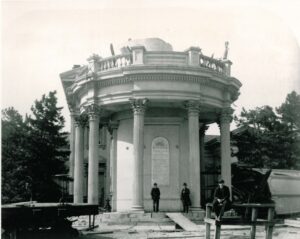 March 27, 1890
March 27, 1890
The Tornado of 1890 killed scores of people downtown and tore up nearly everything in its path. As it headed north up the river, the tornado knocked down the Water Tower snapping off the wooden shaft. As Chief Engineer Charles Hermany wrote in his annual report, “only a short stump of each (the Water Tower and the standpipe) to mock their former height and beauty,” was left behind.
Inside Pumping Station No. 1, the two Cornish pumps, needing the standpipe encased in the Water Tower to operate, were working nearly 24 hours a day to keep up with the demand for water. The standpipe evened out the pressure surges from the dropping of the 58,000 lb. plungers to allow for a smooth flow of water to the Crescent Hill Reservoir. No standpipe meant no pumping. The prospect of running out of a water was very real.
When the pumps were silenced, the Crescent Hill Reservoir was partially filled with only 65 million gallons of water to last a mere six days. To prevent a water famine, water was cut off to elevators, distilleries, breweries, other manufacturers and street sprinkling hydrants. People were asked to conserve their water use. These drastic measures helped for five days. On April 1, the reservoir still held 27 million gallons of water estimated to last for 3 ½ days.
The pumping station needed to get back online and soon, so Hermany did a bit of problem solving. How did he do it? Learn more on Sunday, March 8, at the WaterWorks Museum from noon to 5 p.m. Admission is $5.


